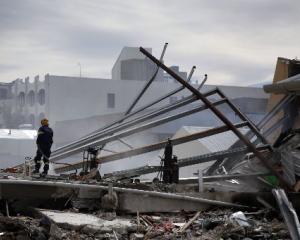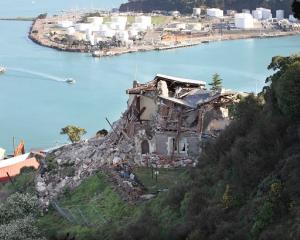One of Christchurch's tallest buildings, the Hotel Grand Chancellor partially collapsed on February 22 because a "vulnerable'' shear wall supporting a considerable load failed, the Royal Commission of Inquiry into the Canterbury earthquakes heard today.
Structural engineer Adam Thornton was giving evidence at the hearing this morning into the failure of the 26-storey building during the fatal magnitude-6.3 quake.
The 16-year-old hotel sustained significant structural damage in the February shake, leaving it teetering on a lean, but no-one died or was seriously injured in the building.
Mr Thornton, who prepared a report into the building for the Department of Building and Housing, said it was "generally well designed.''
However, a vulnerability in one of its shear walls resulted in a major, but local, failure.
The south east shear wall suffered an abrupt "brittle rupture'' and failed at a ground floor level - dropping 800 millimetres.
Mr Thornton said the shear wall had supported "quite a large portion of the tower.''
He said: "As the wall failed and dropped, the load was transferred onto adjacent columns and they were crushed to some extent and dropped. It is fortunate they did not collapse, otherwise it would have brought down a large portion of the building.''
The movement caused by the wall's failure caused other damage including column failure, beam yielding, and the collapse of stairs.
"Some redundancy and resilience within other areas of the structure, which provided alternative load paths, prevented an ongoing building collapse,'' Mr Thornton's report said.
The reason that the south east shear wall failed, where similar walls in the building didn't, was that it had a much larger gravity load.
The report said: "The other walls only had a fraction of that. They had much less load on them.
"In retrospect, if any wall was going to fail it is logical it would be [the south east wall]. It was the most vulnerable.''
Unlike other walls in the building, the south east shear wall did not have a return wall - a wall built perpendicular to a freestanding wall to increase its structural stability.
Mr Thornton said a return wall could have potentially prevented the wall's failure in the earthquake.
He told the hearing: "I think if it was adequately done, yes. A return wall helps the wall in two respects _ it stops it buckling and it reduces high axel stress on the wall.''
He did not know why a return wall was not built, despite the fact this had originally been drawn in on plans.
The engineer added: "There may have been architectural pressures to minimise effects in the hotel lobby.''
The report by Dunning Thornton Consultants said other shear wall failures of similar appearance had been observed in other buildings following the February 22 quake.
It concluded: "This suggests that a review of both code provisions and design practice is warranted.''
More evidence will be given at the commission by engineers this afternoon.
Among the issues the commission will consider is whether the hotel complied with earthquake-risk and other best practice requirements, why the building failed, whether the building had been identified as earthquake-prone on or before September 4, and the effectiveness of inspections carried out on the building following the September 4 earthquake.
The hearing is expected to wrap up tomorrow, with the hotel's general manager Steve Martin, more engineers, and a representative from the city council giving evidence.
Work to bring the hotel down floor by floor began last November and was expected to cost $10 million.
- Anna Turner of The Star






